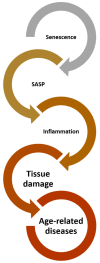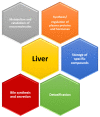Aging of Liver in Its Different Diseases
- PMID: 36361873
- PMCID: PMC9656219
- DOI: 10.3390/ijms232113085
Aging of Liver in Its Different Diseases
Abstract
The proportion of elderly people in the world population is constantly increasing. With age, the risk of numerous chronic diseases and their complications also rises. Research on the subject of cellular senescence date back to the middle of the last century, and today we know that senescent cells have different morphology, metabolism, phenotypes and many other characteristics. Their main feature is the development of senescence-associated secretory phenotype (SASP), whose pro-inflammatory components affect tissues and organs, and increases the possibility of age-related diseases. The liver is the main metabolic organ of our body, and the results of previous research indicate that its regenerative capacity is greater and that it ages more slowly compared to other organs. With age, liver cells change under the influence of various stressors and the risk of developing chronic liver diseases such as non-alcoholic fatty liver disease (NAFLD), non-alcoholic steatohepatitis (NASH), alcoholic steatohepatitis (ASH) and hepatocellular carcinoma (HCC) increases. It has been proven that these diseases progress faster in the elderly population and in some cases lead to end-stage liver disease that requires transplantation. The treatment of elderly people with chronic liver diseases is a challenge and requires an individual approach as well as new research that will reveal other safe and effective therapeutic modalities.
Keywords: DDR; SASP; cell; elderly; inflammaging; liver; senescence.
Conflict of interest statement
The authors declare no conflict of interest.
Figures




References
Publication types
MeSH terms
LinkOut - more resources
Full Text Sources
Medical
Research Materials
Miscellaneous

